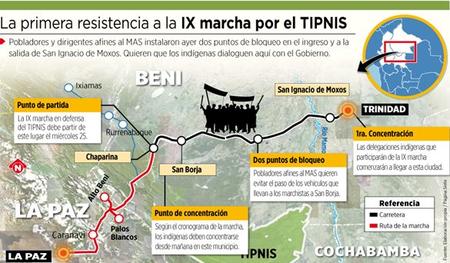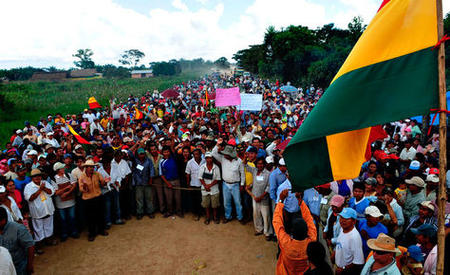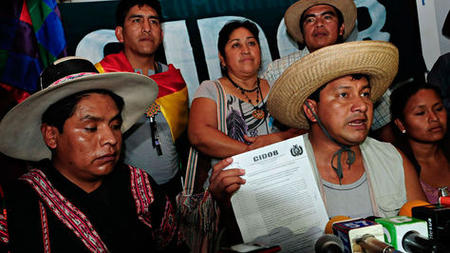After a week fraught with tension, the second march to protest the Bolivian government’s proposed highway through the Isiboro-Sécure Indigenous Territory and National Park (TIPNIS) is set to depart today, April 27, from the Amazonian department of Beni, headed towards the highland capital of La Paz.
Originally scheduled to begin in the village of Chaparina, where participants in the first TIPNIS march were brutally repressed by police last September, the march was rerouted to start from the departmental capital of Trinidad due to a road blockade by highway supporters in San Ignacio de Moxos, preventing access to Chaparina. The protestors are expected to follow the 360-mile route of last year’s march, arriving in La Paz in late June.
Unlike the first TIPNIS march, whose agenda was limited to the proposed highway and related concerns of CIDOB, the lowlands indigenous federation that has co-sponsored both protests, the new march is billed as a national mobilization for indigenous, environmental, and human rights and has actively solicited the participation of urban sectors. According to TIPNIS leader Fernando Vargas, the march is “not against President Evo Morales, but against his policies that violate the rights of Mother Earth and the Bolivian Constitution, approved by the Movement Towards Socialism (MAS) government.”
The highway project has bitterly divided inhabitants of the TIPNIS and of the Beni and Cochabamba departments which would be linked by the proposed road. The five-day blockade, led by the San Ignacio Regional Workers Central and its 30 organizational affiliates, was backed by local MAS government authorities who reportedly threatened residents with utility shut-offs if they failed to participate. Interior Minister Carlos Romero intervened directly to negotiate an agreement disbanding the blockade, at least temporarily.
“The indigenous protesters have a legitimate right to march in peace,” said Romero. “If necessary, the government will provide security and protection to guarantee the march.” This represents a significant departure from the government’s posture during the first TIPNIS march, when federal police effectively reinforced the anti-march blockade at Chaparina and repressed the protesters in order to “save” them from a confrontation.
 The UN Human Rights Commission has encouraged this change of message, along with other steps recently taken by Morales to help defuse current tensions. In addition to cancelling the road contract with Brazilian construction firm OAS, Morales has asked the legislature to extend the controversial community consultation process on the TIPNIS road for another 90 days, through September 10. Romero has also stated that the government is open to “unconditional dialogue” with the TIPNIS protestors, who are boycotting the consulta which they regard as illegitimate.
The UN Human Rights Commission has encouraged this change of message, along with other steps recently taken by Morales to help defuse current tensions. In addition to cancelling the road contract with Brazilian construction firm OAS, Morales has asked the legislature to extend the controversial community consultation process on the TIPNIS road for another 90 days, through September 10. Romero has also stated that the government is open to “unconditional dialogue” with the TIPNIS protestors, who are boycotting the consulta which they regard as illegitimate.
Still, the government has refused to indefinitely suspend the consulta, a step suggested by the UN and several MAS congressional leaders to facilitate the trust, dialogue, and prior agreements needed to legitimize the consultation process. Morales continues to insist that the TIPNIS road is the only feasible route to connect the Beni and Cochabamba departments, and has recently inaugurated helicopter, land, and water tours for reporters to propagandize his position for a captive audience.
Inside the TIPNIS, Morales has continued the controversial practice of delivering outboard motors, solar panels, and promises of development projects in a manner that critics say is timed to deter participation in the march and encourage support for the consulta. Government officials claimed this week that they have secured the support of 52 of 68 indigenous communities for the consulta protocol. The Sécure Subcentral, representing 16 communities and under (contested) new leadership, has reportedly reversed its previous position and now supports the consulta and opposes the march.
Outside the TIPNIS, the government has signed programmatic agreements with 12 of the 13 CIDOB regionals. At least five regionals, including two key indigenous groups in Beni (CPIB and CMIB) are officially boycotting the march. Still, factions within these organizations, including the vice president of CPIB, have shown up in Trinidad to join the march, supporting TIPNIS leaders’ contention that residents will defy local leaders to defend their territory as a matter of conscience.
While the delays, blockades, and internal divisions—along with the absence of Fernando Vargas, felled by dengue fever—have posed early challenges for the march, the relocation of the march route has provided an opportunity for indigenous protesters to strengthen their ties with urban sectors. This week in Trinidad, mobilized public health workers and teachers joined forces with the TIPNIS marchers in a demonstration of solidarity. Some 2,000 workers from the Beni Departmental Workers Central will accompany the march from Trinidad to San Ignacio, reasserting the pro-march stance of the Bolivian Workers Central (COB), its national parent organization, against the dissident regional.
The march is developing at a moment of heightened social conflict in Bolivia, with strikes underway by doctors, public health workers, and urban teachers. Major mobilizations by the COB around wage demands shut down La Paz this week, with significant demonstrations in other departmental capitals.
These constituencies were well represented at a recent meeting in La Paz attended by leaders of some 300 indigenous, labor, environmental, neighborhood, and human rights organizations from five cities, to discuss the formation of an “indigenous-urban alliance" around the TIPNIS issue. If the national TIPNIS march succeeds in joining the demands of these sectors into a unified platform with broad-based support, the consequences could be far-reaching not only for the TIPNIS conflict, but for Bolivia’s political future as well.
Read more on the TIPNIS conflict on Emily Achtenberg's blog, Rebel Currents. See also, the January/February 2011 NACLA Report, "Golpistas! Coups and Democracy in the 21st Century;" the September/October 2010 NACLA Report, "After Recognition: Indigenous Peoples Confront Capitalism;" or the September/October 2009 NACLA Report, "Political Environments: Development, Dissent, and the New Extraction." Or subscribe to NACLA.

